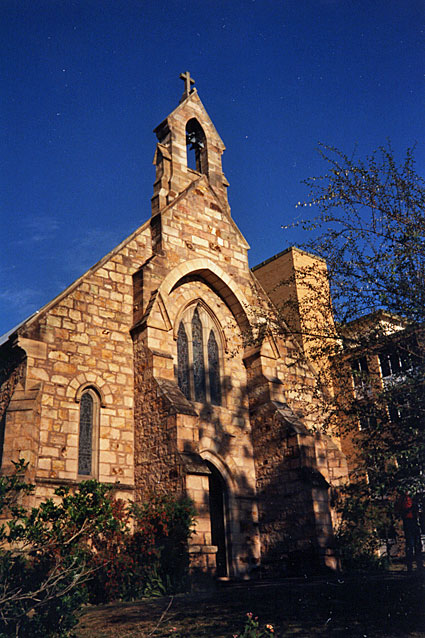
St Mary's Anglican Church, Kangaroo Point
[Photograph by Howard Baker (1990s)]

St Mary's Anglican Church, Kangaroo Point
[Photograph by Howard Baker (1990s)]
Historical and Technical Documentation by Geoffrey Cox1
© OHTA 2011, 2015 , 2017 (last updated July 2017)
Surmounting a tall quarry face on the bank of the Brisbane River opposite the Botanic Gardens, St Mary's Church is a significant historical and visual landmark at Kangaroo Point. The foundation stone of the present church was laid in 1872, and the church was consecrated on 5 November 1873,2 replacing an earlier timber church built nearby in John Street (then Church Lane) in 1849. The building is constructed of porphyry stone (Brisbane tuff) obtained close by. It was designed by the architect, R.G. Suter, who practiced in Brisbane for more than a decade in the 1860s and early 1870s, and who also designed the slightly earlier All Saints' Church, Wickham Terrace, Brisbane.3
The musical aspirations of the parish were high from the start: The consecration service in 1873 was described proudly as 'choral throughout, the regular choir being assisted by members of the choirs of St John's, Fortitude Valley and South Brisbane churches.'4 The organ is considerably older than the church itself: It was installed at Kangaroo Point in 1876, and opened on 31 August of that year:5
On Thursday evening there was a special service at this church, on the occasion of the opening of the new organ, which has just arrived from England, and which has been purchased by subscriptions by the members of the congregation . . . The musical portion of the service was admirably rendered by the choir, which has made great advance of late . . .6
The organ had arrived about a month earlier, according to a newspaper report of 29 July:
A meeting of the parishioners of Kangaroo Point was held on Thursday, on the subject of the organ which has lately arrived, per National, for the use of St Mary's Church. The Rev. D. A. Court, as chairman, gave a brief resumé of the circumstances attending the purchase of the instrument in question, and . . . A vote of thanks was then unanimously passed to Messrs. Devitt and Moore (shipping agents for Messrs. G. Raff & Co.) for their liberality in conveying the organ to Brisbane free of freight; and also to Messrs. Armour & Co., for remitting wharfage dues.7
The history of this organ was the subject of enquiry by John Irving and Edward R. Salisbury in the late 1930s. Details of the original location, specification and early history, however, can only be conjectured.8 External evidence concerning the organ's origin can be found in the nameplate 'H.C. Lincoln, Organ Builder to the King, London', and in a pencilled inscription on the former swell box (no longer in existence), which was discovered by Mr E.R. Salisbury, organist of the church in 1963-64:
This box was made [by H. L.] & Staff
in easter Week March 31st 1823.
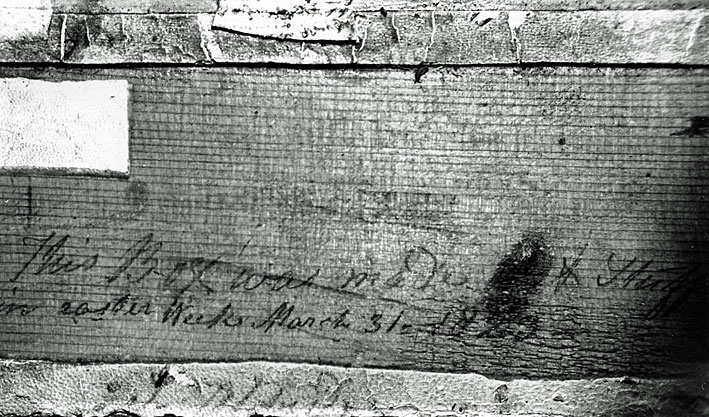
Pencilled inscription on the former swell box
[Photograph (c.1940) supplied by Edward R. Salisbury (1974)]
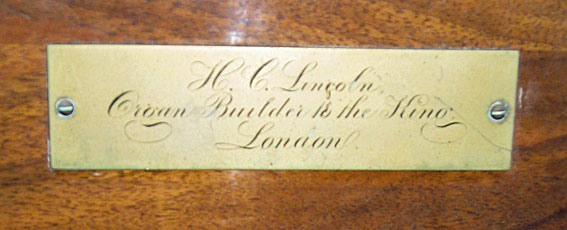
Nameplate of H. C. Lincoln, preserved on the present organ
[Photograph by Geoffrey Cox (July 2011)]
Henry Cephas Lincoln, born in 1788 or 1789, was the son of John Lincoln, also an organ builder, with whom he worked from an early age. After failing to complete contracts for St Olave's, Southwark (awarded 1844) and for the ballroom at Buckingham Palace (1855), he died on 5 March 1864.9 Lincoln's organ for St John's Chapel, Bedford Row, London (1821) was moved in 1858 to Thaxted Parish Church, Essex, where it has survived largely unaltered. Restored in 2013-14 by Goetz & Gwynn of Welbeck, Nottinghamshire, it exhibits traditionally Georgian features such as low-compass keyboards (from low FF, without FF#), but also more modern features such as a Pedal Organ with twenty pipes and a Swell Organ enclosed in a wooden box with a sliding front.10
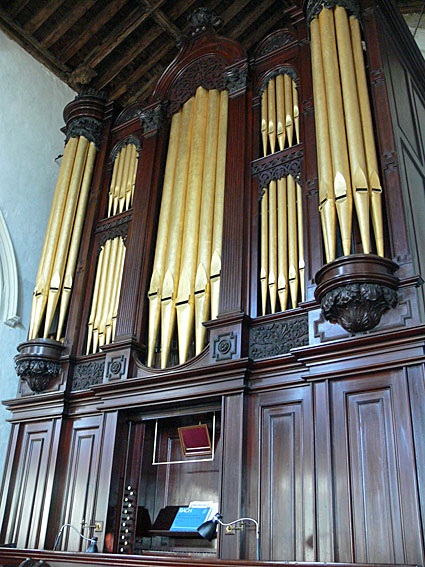
The restored 1821 H.C. Lincoln organ
at Thaxted Parish Church, Essex, UK
[Photograph by John Maidment (July 2015)]
A number of unfounded rumours have been associated with the Kangaroo Point organ over the years: One of these was that it bore 'a plate stating that it was built in 1770.' Whether or not such a plate ever existed, it is possible that Lincoln's work in 1823 was that of altering or enlarging an earlier organ. Another persistent rumour - that the organ came from St. Pancras Church, London - appears to have no factual basis.11
Following the unroofing of St Mary's Church in a cyclone on 2 April 1892, repairs to the church were made, and a new transept was built to accommodate the organ, the church being re-opened on 25 February 1893:
St. Mary's Church of England . . . was unroofed by a cyclone and seriously damaged on the 2nd April, 1892. The old roof has now been replaced by one more substantial . . .
The choir has been extended further into the church, and . . . a transept of two bays has been thrown out to accommodate the organ and to provide extra seats for the congregation.12
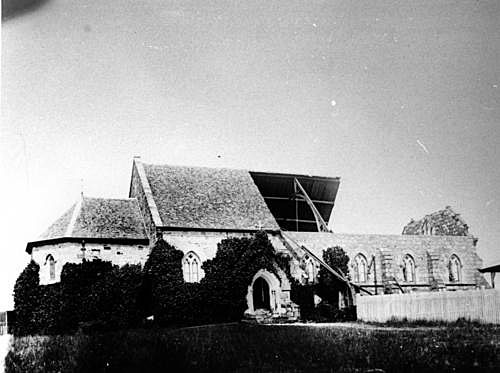
St Mary's Church, Kangaroo Point,
following the cyclone of April 1892
[Photograph: John Oxley Library, State Library of Queensland]
The extent of the damage to the organ is unclear, but it was reported in November 1897 that it had finally been repaired and renovated. The work was carried out by Messrs Whitehouse & Marlor of Brisbane.13
When the organ was re-opened on 4 November 1897, it had 16 stops, and it was stated as 'a matter of pride that the Pedal Bourdon has not its equal in Brisbane.'14 This suggests that all or part of this stop was new at this time. The bellows had been re-leathered, much of the action renewed, and the swell organ had been repaired. Two new stops (a flute and an oboe) were not available in time for the re-opening: They arrived from England in April 1898, and the renovated organ was re-dedicated on 19 May 1898.15
The late Mr Edward Salisbury, organist of St Mary's 1963-64, learned from Mr Joseph Whitehouse, Snr, who was involved in the 1897 repairs, that the Oboe 8ft had replaced a former reed, and that the Flute 4ft (of triangular construction) on the Great had replaced a Sesquialtera. Further he learned that the present Open Diapason on the Great had replaced an older one of exceedingly soft metal. The latter alteration can be dated to September 1922 from an entry in the ledger of Messrs Whitehouse Bros, 'supplying new pipes' at a cost of £56,16 and a plaque on the organ that reads: 'The Open Diapason stop in this organ was given in memory of Beatrice Mary Snow 7-11-1919.' Other records of work undertaken by Whitehouse Bros include repairs in October 1953 at cost of £55.6.8,17 re-leathering the bellows in March 1955, and strengthening the building frame in April 1955.18
Much evidence concerning the original instrument was destroyed in 1961, when the organ was rebuilt, electrified and enlarged by Whitehouse Bros, using new chests, action and console, but some earlier photographs and observations are still available. The Swell soundboard prior to 1961 showed without doubt that the swell compass extended down originally only to fiddle G, giving 35 notes, G-f3, although it was later extended to Tenor C. The late Mr John Irving, organist of St Mary's in the 1930s, deduced from an inspection of the old action that the original compass of the Great extended four notes below the present CC, presumably giving 58 notes, GGG-f3 (without GGG-sharp).19 The original low compass is also in evidence on the console that existed before 1961, where the right jamb was against the right cheek of the manuals, whereas there was a space between the left jamb and the left cheek for a few extra notes.

The console of the organ before 1961
[Photograph (c.1940) supplied by Edward R. Salisbury (1974)]
The entire front section of the present case above the impost appears to be of a later date than the remainder. The pedalboard before 1961 was flat and straight, and there was a combination pedal that added stops 2, 3, 4 and 5 on the Great (see below), and another that removed the same. The action was mechanical, and there were ivory stop knobs, which, according to the late Mr Joseph Whitehouse, had replaced former carved oak knobs with stop names on slips of paper glued to the jambs.
Comparison between the photograph below of the Kangaroo Point console before 1961 and that of the restored Thaxted console reveals obvious similarities in the shape of the stop jambs, the key cheeks and the keyboards. While the tropic pinning of the keys presumably dated from 1897, much of the pre-1961 console appears, therefore, to date from before the post-cyclone repairs of 1897, and to have been built by Lincoln.
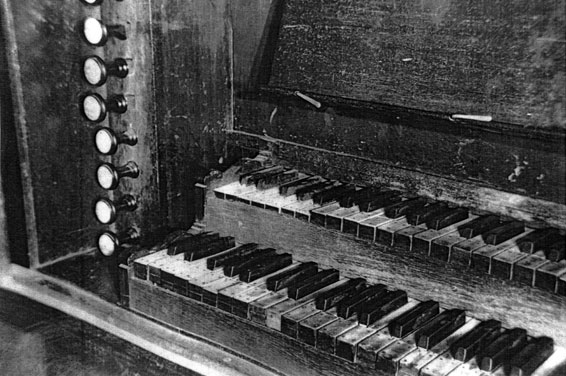
The bass end of the Kangaroo Point console before 1961,
showing tropic-pinned keys, Swell tenor C compass, and ivory drawstops
[Photograph (c.1940) supplied by Edward R. Salisbury (1974)]
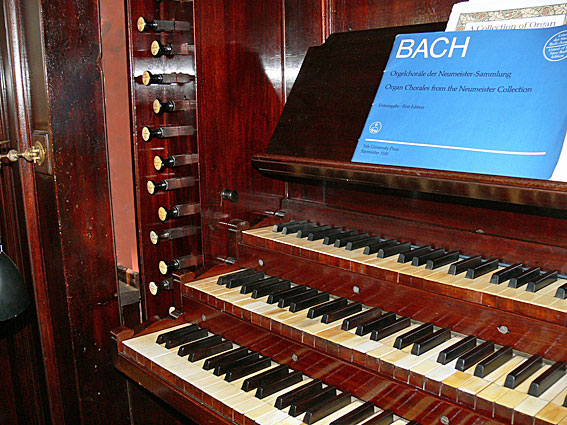
The Bass end of the restored Thaxted console (1821)
[Photograph by John Maidment (July 2015)]
Below is the specification of the Kangaroo Point organ as recorded by Mr Salisbury before 1961. The order of the stops within each department conforms with their original placement on the jambs from top to bottom, and the historical details outlined above are given in square brackets:
GREAT (54 notes, CC-f3) |
(originally 58 notes, GGG-f3, without GGG-sharp)2 | |||
| 1. 2. 3. 4. 5. 6. 7. |
Dulciana Flute Fifteenth Twelfth Principal Stopped Diapason Open Diapason |
8 4 2 2-2/3 4 8 8 |
[1897/98] [1922] |
[not original] [formerly Sesquialtera] |
SWELL (42 notes, C-f3) |
(originally 35 notes, G-f3)21 |
|||
| 8. 9. 10. 11. 12. 13. |
Oboe Gemshorn Lieblich Gedact Open Diapason Tremulant [Spare knob] |
8 4 8 8 |
[1897/98] |
[replaced a former reed] [prepared for only] |
14. 15. 16. |
PEDAL (27 notes, CCC-D) Bourdon COUPLERS Great to Pedal Swell to Great |
16 |
[1897?] |
|
Pedalboard: flat & straight [1897?]
Mechanical action
Lever swell pedal
The unusual position of the Dulciana on the stop jamb at Kangaroo Point suggests strongly that it had replaced an earlier reed, as was often the case in the rebuilding of early nineteenth-century organs.
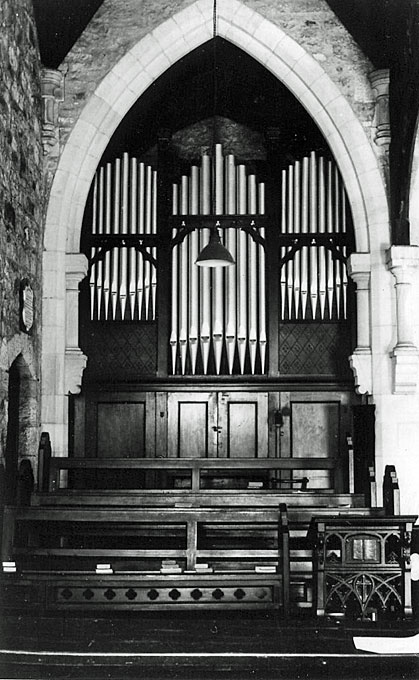
The Kangaroo Point organ before 1961
[Photograph (c.1940) supplied by Edward R. Salisbury (1974)]
Having reconstructed the details of the organ as it appears to have existed when installed at Kangaroo Point in 1876, attempts have been made to identify its original location in England. Details of many such early nineteenth-century English organs survive in contemporary notebooks, including the Sperling Notebooks, which are believed to have been compiled in the period up to 1854,20 and a manuscript copy of a notebook titled 'Account of Organs' by the organ builder, George Pike England.21 With the assistance of the late English organ historian, the Revd Bernard B. Edmonds, possible links were discovered in the 1970s to at least two London churches: Battersea Parish Church, and Wheler Chapel, Spital Square.
The possible connection with Battersea Parish Church (St Mary's) stems from the fact that H. C. Lincoln appears to have built an organ there in 1823. The specification and the date are recorded in the Sperling Notebooks as follows:
BATTERSEA CHURCH
Lincoln 1823. 2 rows of keys.
Great organ GG to f in alt.
1. Open Diapn
2. Stopt Diapason
3. Principal
4. Twelfth
5. Fifteenth
6. Sex 3 ranks Baß
7. Cornet 3 ranks Treble
8. Trumpet in halves
Swell to Fiddle G
1. Open Diapason
2. Stopped Diapason
3. Principal
4. Hautboy
An octave of Open Unison Pedal Pipes GG to G.
Composition Pedals added by Bishop in 1840.22
The date is the same as that given in Lincoln's inscription on the old Kangaroo Point swell box, and the Battersea specification is very close to the one reconstructed for Kangaroo Point. The Battersea Great Mixture was clearly a divided stop (Sesquialtera Bass / Cornet Treble), as was common on English organs from the late seventeenth-century onwards, and the Great Trumpet stop was also divided. The number of manual stops and the respective compasses thus conform with the details at Kangaroo Point. The subsequent history of the Battersea organ, however, tends to rule out any connection with Kangaroo Point: The organ was rebuilt in 1867 by Bishop & Starr, and it was apparently moved to the S.E. corner of the nave in 1878.23
A more plausible (though nonetheless conjectural) connection can be established with Wheler Chapel, Spital Square, London, which was opened in 1692 as a private chapel on Sir George Wheler's estate in Spitalfields. In 1697 a new timber chapel was built, and was re-opened after rebuilding in 1756. In 1842 it was consecrated as the parish church of St Mary, Spital Square, and was closed on 29 June 1911, the site eventually becoming part of Spitalfields Market.24
The first account of an organ in Wheler Chapel appears in G.P. England's 'Account of Organs' as follows:
WHEELER [sic] CHAPEL SPITAL SQUARE
By Lincoln 2 setts of keys long 8ves GG to F
Cost £150
| GT ORG Op di to St di Prin 12th & 15th Sesq 3R SWELL 2 di Trumpet Prin Sesq 3R |
58 58 116 174 70 35 35 174 |
Org: Mr Levesque.25
These details are difficult to date: England died in 1816,26 and his original notebooks were eventually destroyed in Hill's fire of 1883. They survive only in the form of a transcription, and there is evidence that additions were made to them after England's death.27 Translating the above account from the shorthand in which either G.P. England or a copyist wrote it, we have a two-manual organ by Lincoln (not necessarily H.C. Lincoln), with a Great compass of 58 notes from GGG (without GGG#), a Swell compass from 'Fiddle G' and the following specification:
| GREAT (58 notes, GGG-f3) Open Diapason Stopped Diapason Principal Twelfth Fifteenth Sesquialtera SWELL (35 notes, G-f3) Open Diapason Stopped Diapason Trumpet Principal |
3 8 8 4 2-2/3 2 III 3 8 8 8 4 |
The Great Twelfth and Fifteenth presumably drew together on the same stop-knob. No mention is made of pedals in G.P. England's account of this organ, and it appears likely that the Great Open Diapason did not extend to the full compass.
A second account of the organ at Spital Square appears in the Sperling Notebooks. This particular entry was apparently made between 1842, when the chapel became St Mary's Parish Church, and 1854, when the Sperling Notebooks are believed to have been completed:
S. MARY SPITAL-FIELDS
Great organ GG to F, Swell to Tenor F, Keys to GG acting on Gt Organ
[GREAT]
1. Open Diapason
2. Stopt Diapason
3. Principal
4. Fifteenth
5. Sesquialtera 3 ranks Bass
6. Cornet 3 ranks Treble
7. Cremona to Fiddle G
SWELL
1. Open Diapason
2. Stopped Diapason
3. Principal
4. Hautboy
Coupla
Swell to Great
1-1/2 octaves of German Pedals, the lowest notes only have separate pipes.28
The differences between these two accounts of the organ at Spital Square may result from incomplete note-taking on the part of G.P. England or, more likely, from additions to the organ at a later date, but the two accounts appear to refer to one and the same instrument. Furthermore, there is a high level of concordance between these accounts and the reconstructed details of the organ at Kangaroo Point.
Coincidence of dates also supports the conjecture that the Kangaroo Point instrument came from Spital Square. By the early years of the nineteenth century, Wheler Chapel had fallen into a state of disrepair. With the licencing of the prominent evangelical preacher, Rev. Josiah Pratt, to the church in February 1810, however, repairs were commenced and an organ was added. The chapel was re-opened for public worship in October that year.29 The only reference to an organ in the extant church records of Spital Square is mention of the salary for an organist and the organ blower, and expenses for tuning the organ in 1844-45.30 Most significant, however, is the fact that a new organ was installed at Spital Square in 1874 by Messrs Gray & Davison.31
The organ that arrived at Kangaroo Point in 1876, therefore, could conceivably have been removed from Spital Square in 1874. If so, it appears to have been installed there in 1810, and to have had at least a few stops (and pedals) added before the middle of the century. It is possible that it was originally a single-manual instrument to which Lincoln added a Swell (in 1823 according to the inscription discovered at Kangaroo Point), although it is also possible that Lincoln built the entire instrument.
Whatever the case, it is not possible to establish the connection between the two locations with absolute certainty. Around half of the stops on the present instrument date from 1897 or later, and the remainder may not necessarily all originate from 1823, the date on the original swell box.32 Origins before 1823 are certainly suggested by the recent observation that 30 pipes of the Gedact 8ft stop on the Swell (a metal chimney flute) appear to date from the late seventeenth century.33
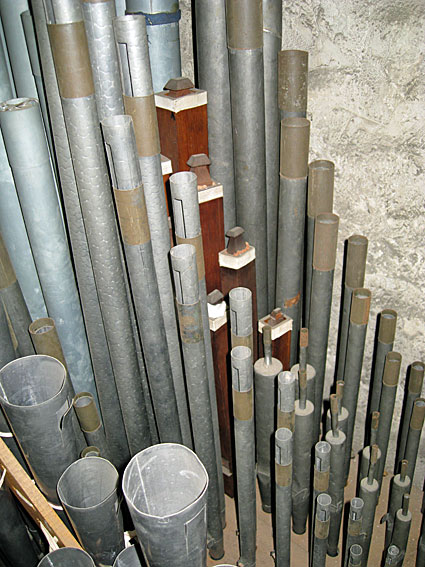

Pipework of the Swell Organ, including the metal chimney flute
thought partly to date from the seventeenth century
(strangely with sliders attached)
[Photograph by Geoffrey Cox (July 2011)]
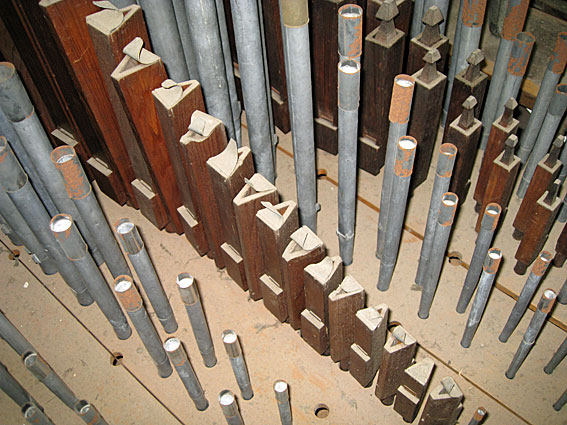
Pipework of the Great Organ,
including the triangular Flute 4ft (1897/98)
[Photograph by Geoffrey Cox (July 2011)]
Although the Kangaroo Point instrument is the only one in Australia bearing any connection with H.C. Lincoln, Lincoln's role in its construction remains unclear. The chequered history of the instrument has severely impaired its heritage value. Cyclone damage in the 1890s and the replacement of various stops in 1897 and 1922 have reduced the quantity of original pipework. Little of the original casework has survived, and what remained of the original soundboards, action and console was removed in 1961 when the instrument was rebuilt and enlarged with cone-pallet chests and electro-pneumatic action by Whitehouse Bros of Brisbane.
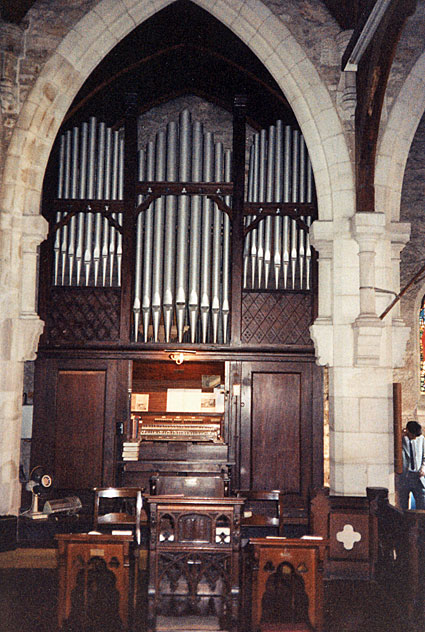
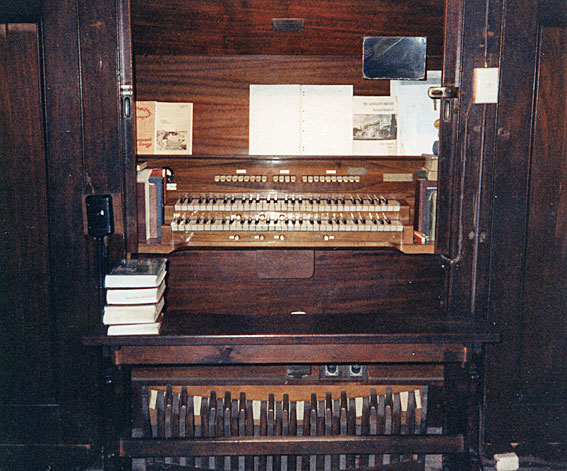
The organ in its present state, following the 1961 rebuild
[Photographs by Howard Baker (1990s)]
The specification since 1961 has been as follows. Additional historical details are given in brackets, based on the documentation provided above:
| GREAT Open Diapason Stopped Diapason Dulciana Principal Flute Twelfth Fifteenth SWELL Diapason Gedact Echo Gamba Gemshorn Cornopean Oboe PEDAL Bourdon Bass Flute |
8 8 8 4 4 2-2/3 2 8 8 8 4 8 8 16 8 |
A A |
[1922] [1897?] [1897/98] [partly 17th century?] [1961] [1961] [1897/98] [1897?] [1961] |
| COUPLERS Great to Pedal Swell to Pedal Swell to Great Swell Octave Swell Sub Octave Swell to Great Super Octave Swell to Great Sub Octave |
|||
General Tremulant
Electro-pneumatic action
Attached stop-key console
Compass: 61/30
Balanced swell pedal
3 thumb pistons to Great
3 thumb pistons to Swell
Swell to Great reversible thumb piston
Great to Pedal reversible toe piston
Full organ reversible toe piston.34
Plans were developed around 2003 to build a new organ incorporating what remains of the early pipework at Kangaroo Point, and modelled to some extent on the extant 1821 Henry Lincoln organ (formerly at St John's Chapel, Bedford Row, London) now at Thaxted Parish Church, Essex,35 although these have not proceeded.
__________________________________________________________________________
1 An earlier version of the historical documentation presented here appeared in 1977 as: Geoffrey Cox, 'An Organ by H. C. Lincoln in Australia,' The Organ, vol. 55, no. 217 (1976-77), pp. 18-23; subsequent correspondence in BIOS Journal, vol. 2 (1978), p. 134.
2 The Brisbane Courier (6 November 1873), p. 2.
3 Queensland Heritage Council, Queensland Heritage Register, location 600244; E.J.A. Weller (ed.), Buildings of Queensland (Brisbane: Jacaranda Press, 1959), p. 32.
4 The Brisbane Courier (6 November 1873), p. 2.
5 'Diary of Events' for 31 August 1876 in Pugh's Queensland Almanac . . . for 1877.
6 The Week, vol. 2, no. 36 (2 September 1876), p. 264.
7 The Week, vol. 2, no. 31 (29 July 1876), p. 122; reprinted in The Queenslander (5 August 1876), p. 9.
8 John Irving and Edward R. Salisbury, (Letter) 'Historic Brisbane Organ,' The Courier-Mail (25 January 1938), p. 12; Ibid., (Letter) 'To Organ Historians: A Query,' Musical Opinion, vol. 62 (September 1939), pp. 1068-70. See also: Edward R. Salisbury, 'The Organ in St. Mary's Church, Kangaroo Point, Brisbane,' unpubl., rpt. in The Organ Voice, vol. 28, no. 2 (June 2002), pp. 10-14. Salisbury's paper was dated 'circa 1970' when reprinted posthumously in The Organ Voice, but was clearly written well before the organ was rebuilt in 1961.
9 Nicholas Thistlethwaite, The H.C. Lincoln Organ in Thaxted Parish Church, Essex. Oxford: Positif Press, 2014, pp. 10-12.
10 Brian Staveley, 'Saving a Georgian Organ,' Organ Australia (Summer 2014-2015), pp. 28-32.
11 Irving and Salisbury, op. cit; Salisbury, op. cit., p. 11.
12 The Brisbane Courier (27 February 1893), p. 6.
13 The Brisbane Courier (6 November 1897), p. 4.
14 Loc. cit.
15 The Brisbane Courier (11 April 1898), p. 10; The Brisbane Courier (19 May 1898), p. 1.
16 Whitehouse Bros Ledger (1922-1940), p. 97.
17 Whitehouse Bros Ledger (1940-1954), p. 245.
18 Whitehouse Bros List.
19 Salisbury, op. cit., p. 12.
20 James Boeringer, 'Further 19th-century accounts of English organs,' The Musical Times, vol. 116 (1975), p. 74.
21 B.B. Edmonds, 'Organ Correspondence and Travel Societies,' The Organ, vol. 52, no. 208 (1972-73), pp. 166-69.
22 Sperling Notebooks, vol. 1, p.165.
23 Charles Mackeson, A Guide to the Churches of London and its Suburbs, for 1889 (London, 1889), cited by B.B. Edmonds.
24 Gordon Barnes, Stepney Churches: An Historical Account (London: Faith Press, 1967), pp. 87-9.
25 Personal communication to G. Cox from B.B. Edmonds, 8 March 1974.
26 Sumner, op. cit., p. 178.
27 B.B. Edmonds, 'Organ Correspondence and Travel Societies,' op. cit; Personal communication to G. Cox from Rev. B.B. Edmonds, 8 March 1974.
28 Sperling Notebooks, vol. 1, p. 61.
29 W.H. Manchée, Spitalfields: Sir George Wheler and his Chapel, St. Mary's, Spital Square (A Paper read to the London and Middlesex Archeological Society at Bishopsgate Institute, 20 April, 1912. Reprinted from the Transactions of the Society), p. 468.
30 Records of St. Mary's, Spital Square, P93/MRY2/16 (Greater London Council Record Office).
31 Manchée, op. cit., p. 474, and Charles Mackeson, A Guide to the Churches of London and its Suburbs, for 1889 (London, 1889), p. 108.
32 Geoffrey Cox, Letter to the Editor, BIOS Journal, vol. 2 (1978), p. 134.
33 Inspection of the instrument in 2004 by Edward Bennett of Goetze & Gwynn, UK. [Personal communication to G. Cox from J. Maidment, 23 April 2004]
34 Specification noted by G. Cox, 1972 and 2011, and from Dedication Programme, 6 August 1961; Details provided in The Organ Voice, vol. 31, no. 3 (September 2004), p. 9 are not complete.
35 John Chappell, 'Authenticity Returns to Brisbane,' The Sydney Organ Journal, vol. 35, no. 1 (Summer 2003-04), pp. 44-45; The Organ Voice, vol. 31, no. 3 (September 2004), pp. 7-10. Details of the Thaxted instrument can be found in Andrew McCrea, 'British Organ Music after 1800,' The Cambridge Companion to the Organ, ed. N. Thistlethwaite and G. Webber (Cambridge: Cambridge University Press, 1998), pp. 279-80, and in Brian Staveley, op. cit.